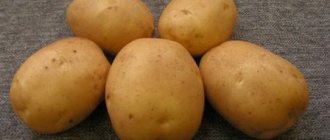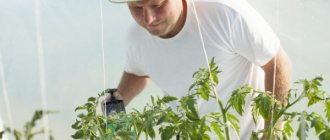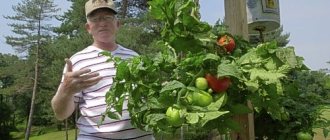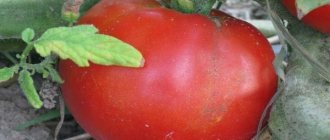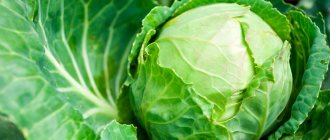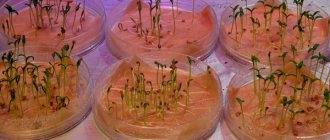How to plant tomatoes with seeds in open ground for the winter
Dry tomato seeds are sown densely in grooves 1-2 cm deep. You can simply sprinkle them in heaps at a distance of 15 cm.
Anyway, only the strongest plants will sprout, so there is no need to make indentations between the seeds. Now you need to mark the place where you planted the tomatoes - you will definitely forget until spring.
To help the seeds survive frosts better, they are additionally covered with spruce branches or green manure .
As an option, sprinkle the planting site with peat or compost. In early spring, it is imperative to clear the bed of cover so that the tomatoes can sprout.
How to treat seeds before planting
Tomato seedlings turn out healthy, dark green, plump. After all, the seeds went through stratification and natural selection over the winter. They rise very well and amicably. The main condition for sowing tomatoes before winter: the seeds must not hatch , otherwise they will freeze.
Let's sum it up
Many people perceive innovations with doubt. Not everyone can dare to use the method of autumn planting tomatoes. The method of growing tomatoes we described was discovered relatively recently, but is already successfully used by many farmers and gardeners.
Its effectiveness lies in the unpretentiousness of the process and early harvest. It is worth thinking about the convenience of this method, analyzing its positive and negative aspects. Compliance with all rules and instructions will help you get a bountiful and early harvest. More information about planting and growing tomatoes before winter is presented in the video:
Planting whole tomatoes before winter
This method couldn’t be simpler, for the laziest. Make a shallow hole and place a whole tomato in it, lightly sprinkle with soil.
Planting depth – 2 cm. Also insulate the top with spruce branches, dry leaves or compost until spring. And with the onset of heat, the shelter must be removed immediately.
The seedlings will sprout in bunches. No additional care required. When the tomatoes grow enough, they are planted immediately in a permanent place.
Advantages of planting tomatoes before winter with whole fruits or seeds
- hardened and healthy seedlings;
- Phytophthora-resistant plants;
- no need to pick, highlight or generally mess with seedlings;
- can be sown in open ground.
Several methods for autumn planting
Fans of experiments have tried several options for winter planting tomatoes. And they recognized that they are all similar, but each has its own characteristics .
READ ALSO: Gray rot on strawberries
Whole tomatoes
This method is the easiest. It is good for experience so that you can decide in the future whether to adopt this method. When the first light frost sets in, dig a hole a few centimeters deep, put a ripe tomato in it and cover it with soil. Build a “coat” of spruce branches and dry leaves or compost on top. With the onset of spring warmth, the shelter must be removed. The seedlings will emerge to the surface in a whole bunch. When they grow a little, they should be planted in a permanent place.
Winter tomatoes in straw
For autumn planting, you need to select ripe fruits from productive healthy bushes in advance and put them in storage until the end of October - beginning of November. With the arrival of the first frosty days, dig holes approximately 15 cm deep. Place rotted straw and one tomato at the bottom of each. Then fill the holes with straw and insulate them with a thick layer of mulch.
When the snow melts, the holes must be protected from returning cold with covering material. A few days after this operation, groups of sprouts will sprout - from 7 to 25 from each planted tomato. When they get stronger, they need to be transplanted into a greenhouse or open ground to a permanent place.
Sowing dry seeds
You can sow in one of two ways: in grooves 1-2 cm deep or in heaps every 15 cm. Cover the top with spruce branches or mowed green manure. Only the healthiest ones will germinate from these seeds, so there is no need to maintain any distance between seeds. After sowing, be sure to mark the planting site so that you don’t have to look for it in the spring. As soon as the first spring warmth arrives, the bed should be cleared to give freedom to seedlings.
Considering that the seeds underwent natural stratification during the winter months, they will germinate very well. The seedlings will be stocky, hardened and will not need means to combat diseases and insect pests.
Pre-winter sowing differs from traditional sowing. Therefore, the gardener must:
- know the rules for winter sowing of seeds;
- replace or disinfect the top layer of soil with a weak solution of potassium permanganate;
- Do not put off greenhouse repairs until spring; they need to be done before the onset of frost.
For your information: winter tomato seedlings are initially inferior in growth to home seedlings, but within a month they catch up with them. And then the seedlings’ ability to resist diseases and pests is revealed.
How to plant tomatoes before winter
There are several ways to plant tomato seeds before winter. Everyone will be able to choose the one that is most convenient and acceptable for them. The main thing is to know the basic sowing rules. Let's talk about four methods that are most often used by gardeners:
- Planting tomatoes in a greenhouse.
- Planting before winter under straw.
- Sowing seeds for compost.
- Planting with whole fruit.
How to plant seeds in a greenhouse
The greenhouse can be made of any material. Many people plant tomatoes in a polycarbonate greenhouse, but this is not necessary. You can build a greenhouse yourself in the fall from scrap materials.
When to plant tomatoes in a polycarbonate greenhouse? This usually happens in November-December. First, prepare the soil for planting. The earth is dug up using a shovel and small trenches are made. Some gardeners prefer holes, but trenches are convenient to water later; they are deep enough, so the seeds will not freeze.
The trenches are leveled, and a small amount of garden or forest soil is placed at the bottom. Then they begin planting.
Important! The seeds must be dry; only dry seeds can survive down to -25°C frost.
The distance between the tomatoes should be small; the seeds are sown often, leaving about 5 centimeters between them. It doesn’t matter if they all sprout in the spring. You can always pick out excess seedlings. The seeds are sprinkled with a small layer of humus and soil on top. The seeds will remain in this form until spring. In spring, care for seedlings is the most common and does not require extra effort.
Planting seeds under straw
In September, you need to prepare the soil for planting tomatoes before winter. To do this, dig up the soil thoroughly, adding rotted manure or humus. You can apply fertilizers with phosphorus and potassium (in small quantities).
For this method you will need a lot of straw - 12 kg/1 sq. landing meter. The soil must be disinfected with a solution of potassium permanganate. The holes for planting should be deep (about 15 cm). A layer of straw is placed at the bottom of each hole, on which a strongly ripened tomato is placed. You can use rotten fruit, unless it began to rot due to illness.
You may be interested in: Caring for strawberries in the fall. Preparing for winter. Autumn planting of seedlings.
The tomatoes are covered with straw and compost on top. This is followed by another 12 cm layer of straw. You can forget about planting until spring. As soon as it gets warmer, you need to create a mini-greenhouse over the beds with tomatoes. This will help the seedlings begin to grow.
Ready seedlings can be planted in permanent beds. If such seedlings differ in growth from home seedlings, do not worry. Within a month they will catch up with her.
Planting on compost
Seeds can be sown in open ground at the end of October. It is better to use winter-hardy varieties. For planting, the soil is prepared as described above. A layer of compost is laid out in trenches or holes, and seeds are placed on it. The top of the beds is sprinkled with soil and covered with leaves and branches.
In the spring, a bed with planted tomatoes will be easy to find, but it will have to be protected from spring frosts and winds with agrofibre or film. As soon as real leaves appear, the seedlings are transplanted into the greenhouse. This method is suitable for planting tomatoes before winter in the Moscow region.
Planting a whole tomato
Gardeners' concerns about planting tomatoes before winter are understandable. But you can try to plant a whole tomato before winter, and play it safe by classically planting seedlings.
For the sake of experiment, try making a meter by meter hole in the garden and putting a bucket of compost in it. Place overripe tomatoes (several pieces) on it and sprinkle with soil. You don’t have to cover anything on top, but you can put spruce branches, foliage or just branches. Over the winter, the pulp of the fruit will completely rot, and the seeds will sink into the soil under the influence of melt water. You can also plant a whole tomato under straw.
In spring the first shoots will appear. To protect them, it is better to cover the pit with covering material. Grown plants from the compost heap are transplanted into permanent beds.
Methods for winter sowing tomatoes
Planting tomatoes for the winter involves several basic methods. Although they are similar to each other, there are still certain differences. Let's look at each of them in more detail.
Sowing under straw
A widespread method of planting tomatoes for the winter using straw. In this case, brown spot and root rot are not a problem for tomatoes.
You will need approximately 10 kg of straw per 1 sq. m. We disinfect the soil with a 1% solution of potassium permanganate. We cover the bottom of the dug holes (15-20 cm deep) with rotted straw. Next we place large and ripe fruits.
Pre-winter planting of tomatoes - is it worth trying?
Which gardener has not encountered the self-seeding of certain plants in the garden - forgotten fruits sprout even deep underground. Some lovers of order pull out trespassers, and some carefully observe the result, and this result sometimes surprises even the most experienced. The idea of winter sowing belongs to precisely such experimenters, although they only allowed Mother Nature to manage the plot a little. So what benefits can you get from planting seeds in the ground over the winter?
Pre-winter sowing of seeds
- The seeds are hardened throughout the winter, being in optimal humidity conditions. This hardening makes tomato bushes absolutely resistant to late blight and even light frosts. The cold kills pathogenic bacteria and viruses that could remain on the planting material.
- Seeds receive a huge boost from melt water - it replaces all the newfangled drugs to protect against bacteria and stimulate growth.
- Shoots appear when weather conditions are optimal for them. Believe me, these little seeds know much better when to start growing than all agronomists combined.
- Shoots appear in moisture-saturated soil at a time when many weeds are still dormant and do not interfere with development. As practice shows, such tomatoes even outgrow seedlings that were grown in the usual way - in a greenhouse or on a windowsill.
- The plants are stronger, stronger, with a developed root system. Of course, the harvest will be many times larger, even if the weather is dry in the summer.
- Saving time - planting tomatoes before winter frees up valuable time, which is so lacking in the spring, when you need to sow everything at once. In addition, in this case you can do without picking.
Planting tomatoes before winter
With the best intentions, we ourselves make our plants weak and unaccustomed to the whims of nature. How to overcome all doubts and fears? It's simple - even if you doubt success, nothing prevents you from allocating one square meter in your garden for a small experiment that won't take you much time. At the same time, protect yourself using the usual method of obtaining seedlings.
Transplanting into a greenhouse bed and care
For planting in a greenhouse, well-developed seedlings without damage at the age of 2 months are selected. Plants are planted in two rows alternately in a checkerboard pattern at the rate of 4 plants per 1 m². The distance between plants in a row is 35 cm, between lines is 50 cm, and between double rows is about 1 m.
Double rows of seedlings
You need to plant seedlings using the transshipment method, deepening them to the cotyledon leaves. Each plant is tied with twine to a wire or crossbar, which is located at the top of the greenhouse, grasping it under the first flower cluster. The tomato is twisted around the twine, this entanglement is repeated every time the top grows by 10 cm.
Tall plants form one stem, short plants form two or three. Tall varieties grow up to 1 m, after which they pinch off the growing point. Further cultivation includes lighting, watering, loosening the soil, ventilating the plantings, and fertilizing.
Watering
Water the plants in the morning with settled warm water at a temperature of +18 °C..+20 °C as the soil around the bush dries out.
Important! Tomatoes do not like overwatering - with high humidity, the ovary crumbles, the leaves and stems are affected by fungal diseases.
You need to water the tomatoes correctly: the soil should be sufficiently moist and the air in the greenhouse should be half (50%) dry.
You need to regulate watering like this:
- water once every 4 days;
- add a medium bucket (5 liters) of water under each bush;
- You need to water in the hole under the bush, without irrigating the leaves;
- You need to moisten the soil in the morning, or better yet, immediately after sunset, with water heated during the day.
A container of water is placed on the south side of the greenhouse, heated by sunlight during the day, and then used for watering.
Important! If the container is located directly in the greenhouse, it is covered with a lid so that the water does not evaporate, otherwise this will lead to increased air humidity.
A rational solution is to organize drip irrigation. In this case, the water goes directly to the roots.
WINTER VEGETABLES
You can give many examples of various agricultural techniques for growing other vegetables, but I want to focus on winter sowing. The “winter” carrots were shot in the spring, but the onions pleased us with their yield and quality. Last fall we planted three different types - regular, white and purple. I noticed that it is better to plant it in late autumn, closer to frost, then it bolts less. Garlic was planted traditionally after the Intercession, choosing a day during the waning Moon and the zodiac sign - Taurus or Capricorn. For the first time, garlic was planted not only with cloves, but also with medium-sized heads as a whole. I also purchased two heads of huge Dutch garlic (100 g each) - the name is complex, starting with the letter “M”. Let's see what the garlic and onion beds will bring you.
In addition, I noticed that in the spring the carrion seeds of tomatoes germinate, surviving the winter and, by the way, producing a good harvest after lying under the snow in winter. Such tomatoes, grown from hardened seeds, are almost not affected by late blight.
RARE PLANT SEEDS FOR YOUR GARDEN - FREE DELIVERY. PRICES ARE VERY LOW. THERE ARE REVIEWS
So last fall we decided to plant tomatoes for the winter. Moreover, part of the greenhouse where cabbage and cucumber seedlings are grown has become vacant. Since seeds are usually selected from ripe fruits and fermented, we decided to plant whole tomatoes.
Everything turned out to be very simple. The year before last, we took chicken manure out of the garden, into the planting (we have two dozen chickens in our dacha), and during this time it rotted. We sprinkled it with a little earth and laid four tomatoes of different varieties on top, also lightly sprinkling them with earth and covering them with a layer of fallen leaves. The place turned out to be quite warm, protected from the wind.
When the snow melted, green shoots appeared in the form of small flower beds. With a clod of earth, they were transferred to a greenhouse under agrofibre to protect them from possible frosts. In May, the tomatoes were carefully divided and planted in their permanent place. At first, winter tomatoes lagged behind seedlings grown in greenhouse conditions, but after a while all the seedlings leveled off. The first time we decided not to risk it and grew some of the seedlings in the usual way.
Sowing tomatoes before winter. A unique way of growing without seedlings. Issue 198
LiveInternetLiveInternet
—Tags
—Categories
- Landscapes (439)
- information (83)
- MESSAGES (80)
- PRAYERS (39)
- Drawing lessons (36)
- MINDFULNESS (34)
- Horoscope for 2014 (24)
- AKASHA Chronicles (21)
- "Primary Source" (20)
- KRYON HOROSCOPE (14)
- FATHER ABSOLUTE (13)
- Horoscope 2015 (13)
- FABERLIC (12)
- Basic course of computer lessons (10)
- Tree of Life (8)
- Technique of wish fulfillment (8)
- Horoscope 2021 (6)
- Neumyvakin (5)
- horoscope 2021 (4)
- RPT (4)
- Catalog of perennial plants in the country (3)
- Horoscope for 2021 (3)
- YUSUPOV Working with the SUBCONSCIOUS (3)
- Louise HAY (3)
- Levashov (3)
- Starovoitova (3)
- JANOS codes (3)
- Chichagov (3)
- GOLTIS (3)
- Homeopathy (3)
- MANDALA (2)
- Angelovskaya (2)
- New Year's (2)
- documents of Novorossiya (2)
- Angel Watch 2021 (1)
- WebMoney (1)
- HISTORY (1)
- Vladimir Putin's Russia (1)
- Slavic horoscope (1)
- Vegetation - details (1)
- Gifts from Svetlana Kozlova (1)
- Battle for Germany (1)
- RAKOV (1)
- collection of recipes (1)
- GUIDE TO THE INTERNET (1)
- SU JOK (1)
- Yoga of LOVE (1)
- Levashov (0)
- Recommend (0)
- Rusnak (0)
- AMAZON (0)
- "Sacred Felines" (4)
- 2012 - live with love (175)
- 2013 - we live happily (121)
- Abkhazia (16)
- Aura of Magic (7)
- Ayurveda (13)
- Business (36)
- Buteyko (9)
- Vadim Zeland (10)
- Oriental medicine (2)
- Horoscope (72)
- Gubanov (3)
- Indigo Children (1)
- Doreen Virtue (10)
- Other realities (17)
- Life without limits. (13)
- Affected (230)
- Hooked. (83)
- health (507)
- Gold pens (135)
- Games (15)
- YESHUA (53)
- Studyable (54)
- interesting (437)
- Interesting people (222)
- Art (414)
- The story of a disease. (10)
- Healing (20)
- Yoga (16)
- quilling (111)
- Movies (57)
- Chinese healing music (3)
- Classical music for health (3)
- Klyuev A.V. (3)
- Mastery Keys (21)
- Books (1)
- Computer ABC (13)
- KRYON (183)
- Beauty (472)
- Beauty of the world (334)
- Circle of Light (34)
- Lazarev S. (16)
- Lebishchak. LESSONS (15)
- Liz Burbo (10)
- Magic exercises (8)
- The magic of psychology (756)
- Meditation (14)
- SILVA method (3)
- Animal World (613)
- WORLD CREATION (4)
- My hobbies (1053)
- MUDRA (21)
- music (82)
- Cartoons (36)
- Folk experience in health improvement (2582)
- Numerology (27)
- Numerology of women's vocation (3)
- About the soul (101)
- Eye of Rebirth (4)
- Rejuvenation (94)
- OSHO (50)
- Palienko (48)
- Gifts (33)
- Spine (3)
- Messages to Creators (2)
- Proverbs (363)
- Business Psychology (21)
- Working on yourself (271)
- Reflections (118)
- Miscellaneous information (21)
- Rami Blackt (33)
- Recipes (2873)
- spring of health (16)
- RODOSVET (139)
- RUSSICHI (2)
- SIMORON (81)
- Smeshinki (225)
- Dreams of the Blessed Virgin Mary (2)
- Housekeeping tips (263)
- Create yourself (3)
- poems (168)
- The secret becomes clear (2)
- Immortality Technology (8)
- TIZH (2)
- Human character types (36)
- Torsunov (12)
- Amazingly amazing (2980)
- Amazing man (21)
- Smart Tips (511)
- Smart thoughts (352)
- Learning and improving (83)
- Fantasy (48)
- Financial independence LESSONS (1)
- Chronicles of Transition 2012 (229)
- Chakras (17)
- What if? (2)
- Esoterics (366)
- Electronic library (2)
- Elixir of life. Kryzhanovskaya V.I. (13)
- Encyclopedias (3)
—Search by diary
—Subscription by e-mail
-Friends
-Statistics
One fruit - everything is like in the wild!
Using this method of sowing tomatoes before winter, you will get as close as possible to the conditions that arise in nature without our participation. The advantage of this method is minimal labor costs. You will need to select some of the most ripe and attractive fruits from the bushes in late autumn. Hybrids do not participate in this selection. Try to ensure that the tomatoes come from the most productive and strong bushes - such planting material will inherit the endurance and productivity of its “parent”.
Ripe and attractive tomato fruits
Place the whole tomato on the compost heap. If there are several tomatoes, there should be a distance of 10–20 cm between them. You can create a bed 1 square meter in size by placing a couple of buckets of compost in the soil. The main thing is that it is already completely rotted fertilizer, since fresh manure during the process of rotting creates a high temperature, which can cause untimely germination of seeds.
It would be correct to sprinkle the tomatoes lightly with soil, and also cover them with spruce branches or thick branches so that birds do not peck them during the winter. The main thing is not to forget where you decided to plant the bed. In the spring, as soon as the snow melts, the seeds will begin to sprout. Clear the pile or bed of branches so that nothing interferes with the sprouts. The seedlings will be dense, so as soon as the first leaf appears, it will be correct to plant the plants sparser. If return frosts are expected, arrange a bed covered with agrofibre. Caring for seedlings is the same as usual - watering, removing weeds, picking. Tomatoes love it when they are transplanted to a new place, where they get sick for a short time and then begin to actively grow.
Covering a tomato bed with agrofibre
Bushes may be stunted in growth at first compared to those grown on a windowsill. As soon as warm weather arrives, they will catch up and even overtake ordinary seedlings. Winter tomatoes will bear fruit until frost.
Exotic way
Throw soured pickled tomatoes (not canned) onto a compost heap or into humus. In early spring, compost is scattered around the site as organic fertilizer. It is likely that the tomatoes will sprout even with such careless planting.
Lost weight: what Sofia Tarasova sacrificed for the sake of “VIA Gra” (new photos)
Rare shot: Viktoria Isakova showed her grown-up daughter from Yuri Moroz (new photo)
A Brazilian travels 36 km by bike every day to take his loved one home.
Advantages of winter sowing
The new technology attracts special attention from farmers in central Russia and the northern regions, where spring comes with some delay. Experts note the attractive aspects of the new technology:
- the plant will be hardened by its winter stay in the soil, so light frosts and most diseases are not scary for them;
- seeds do not need to be soaked and treated with fungicides and growth stimulants, since all bacteria are destroyed by frost;
- melt water will become a natural growth stimulator for seeds and protection against harmful microorganisms;
- the time of emergence of seedlings corresponds to the laws of nature;
- tomato bushes grow stocky and healthy, with a powerful root system, they do not need picking;
- plants will give a good harvest even in dry summers, in the absence of rain and watering, since their roots grow deep.
The gardener also benefits: he saves time and effort, which is so needed in the spring. The main thing is that he will get rid of the headache of growing seedlings.
Online shopping rules for summer residents: buying seedlings
